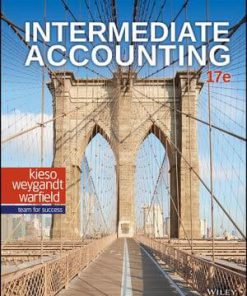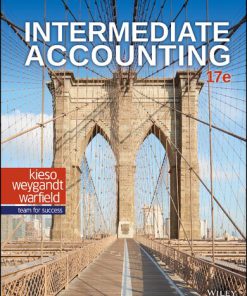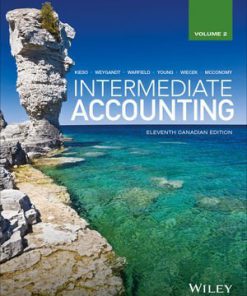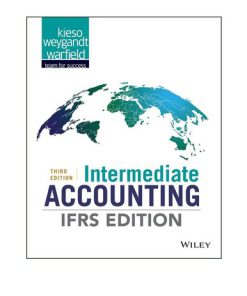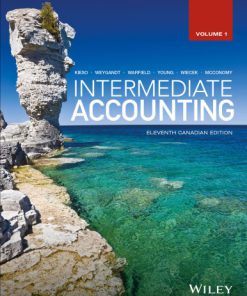Intermediate Accounting 11th edition by David Spiceland 1264387403 9781264387403
$50.00 Original price was: $50.00.$25.00Current price is: $25.00.
Intermediate Accounting 11th edition by J. David Spiceland – Ebook PDF Instant Download/DeliveryISBN: 1264387403, 9781264387403
Full download Intermediate Accounting 11th edition after payment.

Product details:
ISBN-10 : 1264387403
ISBN-13 : 9781264387403
Author: J. David Spiceland
The Spiceland/Nelson/Thomas/Winchel author team has created the new standard in Intermediate Accounting by providing students with the most accessible comprehensive and current Intermediate Accounting learning system. The rigorous yet readable approach has won over instructors across the country while the conversational and consistent voice of this highly dedicated and deeply engaged author team has significantly improved student understanding. The Spiceland team is committed to providing current comprehensive and clear coverage of Intermediate Accounting and the newest edition continues to leverage Connect as the premier digital teaching and learning tool on the market. Spiceland/Nelson/Thomas/Winchel’s Intermediate Accounting excels in fully preparing students for the CPA exam and their future careers through the materials’ highly acclaimed conversational writing style carefully tuned pedagogy and wealth of online tools. The authors help students develop a better understanding of both theoretical and practical concepts guiding them to a more complete mastery of accounting principles.
Intermediate Accounting 11th Table of contents:
Chapter 1: Environment and Theoretical Structure of Financial Accounting
Introduction
Part A: Financial Accounting Environment
Financial Accounting Environment
The Economic Environment and Financial Reporting
The Investment-Credit Decision—A Cash Flow Perspective
Cash versus Accrual Accounting
The Development of Financial Accounting and Reporting Standards
Historical Perspective and Standards
The Standard-Setting Process
Encouraging High-Quality Financial Reporting
The Role of the Auditor
Financial Reporting Reform
A Move Away from Rules-Based Standards?
Ethics in Accounting
PART B The Conceptual Framework
The Conceptual Framework
Objective of Financial Reporting
Qualitative Characteristics of Financial Reporting Information
Fundamental Qualitative Characteristics
Enhancing Qualitative Characteristics
Key Constraint: Cost Effectiveness
Elements of Financial Statements
Underlying Assumptions
Economic Entity Assumption
Going Concern Assumption
Periodicity Assumption
Monetary Unit Assumption
Recognition, Measurement, and Disclosure Concepts
Recognition
Measurement
Disclosure
Evolving GAAP
The Bottom Line
Questions For Review of Key Topics
Brief Exercises
Exercises
Decision Makers’ Perspective
Data Analytics & Excel
Continuing Cases
Chapter 2: Review of the Accounting Process
Introduction
Part A: Overview of the Accounting System
Overview of the Accounting System
Steps in the Accounting Cycle
Part B: The Accounting Cycle—During the Period
The Accounting Cycle—During the Period
Transaction Analysis and Journal Entries
General Ledger and Unadjusted Trial Balance
Part C: The Accounting Cycle—End of the Period
The Accounting Cycle—End of the Period
The Financial Statements
The Income Statement and the Statement of Comprehensive Income
The Balance Sheet
The Statement of Cash Flows
The Statement of Shareholders’ Equity
The Closing Process
Conversion from Cash Basis to Accrual Basis
The Bottom Line
Appendix 2A: Using a Worksheet
Appendix 2B: Reversing Entries
Appendix 2C: Subsidiary Ledgers and Special Journals
Subsidiary Ledgers
Special Journals
Sales Journal
Cash Receipts Journal
Questions For Review of Key Topics
Brief Exercises
Exercises
Problems
Decision Makers’ Perspective
Data Analytics & Excel
Continuing Cases
Chapter 3: The Balance Sheet and Financial Disclosures
Introduction
Part A: The Balance Sheet
The Balance Sheet
Usefulness
Limitations
Classification of Elements
Assets
Liabilities
Shareholders’ Equity
Part B: Annual Report Disclosures
Annual Report Disclosures
Disclosure Notes
Summary of Significant Accounting Policies
Subsequent Events
Noteworthy Events and Transactions
Management’s Discussion and Analysis
Management’s Responsibilities
Compensation of Directors and Top Executives
Environmental, Social, and Governance (ESG) Disclosures
Auditor’s Report
Part C: Risk Analysis
Risk Analysis
Using Financial Statement Information
Liquidity Ratios
Solvency Ratios
The Bottom Line
Appendix 3: Reporting Segment Information
Reporting by Operating Segment
Questions For Review of Key Topics
Brief Exercises
Exercises
Problems
Decision Makers’ Perspective
Data Analytics & Excel
Continuing Cases
Chapter 4: The Income Statement, Comprehensive Income, and the Statement of Cash Flows
Introduction
Part A: The Income Statement and Comprehensive Income
The Income Statement and Comprehensive Income
Income from Continuing Operations
Revenues, Expenses, Gains, and Losses
Operating Income versus Nonoperating Income
Income Tax Expense
Income Statement Formats
Earnings Quality
Income Smoothing and Classification Shifting
Operating Income and Earnings Quality
Nonoperating Income and Earnings Quality
Non-GAAP Earnings
Discontinued Operations
What Constitutes a Discontinued Operation?
Reporting Discontinued Operations
Accounting Changes
Change in Accounting Principle
Change in Accounting Estimate
Change in Depreciation, Amortization, or Depletion Method
Correction of Accounting Errors
Prior Period Adjustments
Earnings per Share
Comprehensive Income
Statement of Comprehensive Income
Balance Sheet—Accumulated Other Comprehensive Income
Part B: The Statement of Cash Flows
The Statement of Cash Flows
Usefulness of the Statement of Cash Flows
Classifying Cash Flows
Operating Activities
Investing Activities
Financing Activities
Noncash Investing and Financing Activities
Part C: Profitability Analysis
Profitability Analysis
Activity Ratios
Profitability Ratios
Profitability Analysis—An Illustration
The Bottom Line
Appendix 4: Interim Reporting
Reporting Revenues and Expenses
Reporting Unusual Items
Earnings per Share
Reporting Accounting Changes
Minimum Disclosures
Questions For Review of Key Topics
Brief Exercises
Exercises
Problems
Decision Makers’ Perspective
Data Analytics & Excel
Continuing Cases
Chapter 5: Time Value of Money Concepts
Introduction
Part A: Basic Concepts
Basic Concepts
Time Value of Money
Simple versus Compound Interest
Future Value of a Single Amount
Present Value of a Single Amount
Solving for Other Values When FV and PV Are Known
Preview of Accounting Applications of Present Value Techniques—Single Cash Amount
Part B: Basic Annuities
Basic Annuities
Future Value of an Annuity
Future Value of an Ordinary Annuity
Future Value of an Annuity Due
Present Value of an Annuity
Present Value of an Ordinary Annuity
Present Value of an Annuity Due
Present Value of a Deferred Annuity
Solving for Unknown Values in Present Value Situations
Determining the Annuity Amount When Other Variables Are Known
Determining the Periods When Other Variables Are Known
Determining the Rate When Other Variables Are Known
Determining When Other Variables Are Known—Unequal Cash Flows
Preview of Accounting Applications of Present Value Techniques—Annuities
Valuation of Long-Term Bonds
Valuation of Long-Term Leases
Valuation of Installment Notes
Valuation of Pension Obligations
Summary of Time Value of Money with Excel
The Bottom Line
Questions For Review of Key Topics
Brief Exercises
Exercises
Problems
Decision Makers’ Perspective
Continuing Cases
Chapter 6: Revenue Recognition
Introduction
PART A Introduction to Revenue Recognition
Introduction to Revenue Recognition
Recognizing Revenue at a Single Point in Time
Recognizing Revenue over a Period of Time
Criteria for Recognizing Revenue over Time
Determining Progress toward Completion
Recognizing Revenue for Contracts that Contain Multiple Performance Obligations
Step 2: Identify the Performance Obligation(s)
Step 3: Determine the Transaction Price
Step 4: Allocate the Transaction Price to Each Performance Obligation
Step 5: Recognize Revenue When (or as) Each Performance Obligation Is Satisfied
PART B Special Issues in Revenue Recognition
Special Issues in Revenue Recognition
Special Issues for Step 1: Identify the Contract
Special Issues for Step 2: Identify the Performance Obligation(s)
Special Issues for Step 3: Determine the Transaction Price
Special Issues for Step 4: Allocate the Transaction Price to the Performance Obligations
Special Issues for Step 5: Recognize Revenue When (or as) Each Performance Obligation Is Satisfied
Disclosures
PART C Accounting for Long-Term Contracts
Accounting for Long-Term Contracts
Accounting for a Profitable Long-Term Contract
A Comparison of Revenue Recognized over the Term of the Contract and at the Completion of Contract
Long-Term Contract Losses
The Bottom Line
Questions For Review of Key Topics
Brief Exercises
Exercises
Problems
Decision Makers’ Perspective
Data Analytics & Excel
Continuing Cases
Chapter 7: Cash and Receivables
Introduction
Part A: Cash and Cash Equivalents
Cash and Cash Equivalents
Internal Control
Internal Control Procedures—Cash Receipts
Internal Control Procedures—Cash Disbursements
Restricted Cash and Compensating Balances
Decision Makers’ Perspective
Part B: Current Receivables
Current Receivables
Accounts Receivable
Initial Valuation of Accounts Receivable
Subsequent Valuation of Accounts Receivable
Notes Receivable
Short-Term Interest-Bearing Notes
Short-Term Noninterest-Bearing Notes
Long-Term Notes Receivable
Subsequent Valuation of Notes Receivable
Financing with Receivables
Secured Borrowing
Sale of Receivables
Transfers of Notes Receivable
Deciding Whether to Account for a Transfer as a Sale or a Secured Borrowing
Disclosures
Decision Makers’ Perspective
The Bottom Line
APPENDIX 7A Cash Controls
Bank Reconciliation
Petty Cash
Questions For Review of Key Topics
Brief Exercises
Exercises
Problems
Decision Makers’ Perspective
Data Analytics & Excel
Continuing Cases
Chapter 8: Inventories: Measurement
Introduction
Part A: Recording and Measuring Inventory
Recording and Measuring Inventory
Types of Inventory
Merchandising Inventory
Manufacturing Inventories
Types of Inventory Systems
Perpetual Inventory System
Periodic Inventory System
A Comparison of the Perpetual and Periodic Inventory Systems
What Is Included in Inventory?
Physical Units Included in Inventory
Transactions Affecting Net Purchases
Inventory Cost Flow Assumptions
Specific Identification
Average Cost
First-In, First-Out (FIFO)
Last-In, First-Out (LIFO)
Comparison of Cost Flow Methods
Factors Influencing Method Choice
LIFO Reserves and LIFO Liquidation
Part B: Methods of Simplifying LIFO
Methods of Simplifying LIFO
LIFO Inventory Pools
Dollar-Value LIFO
Cost Indexes
The DVL Inventory Estimation Technique
Advantages of DVL
The Bottom Line
Questions For Review of Key Topics
Brief Exercises
Exercises
Problems
Decision Makers’ Perspective
Data Analytics & Excel
Continuing Cases
Chapter 9: Inventories: Additional Issues
Introduction
Part A: Subsequent Measurement of Inventory
Subsequent Measurement of Inventory
Lower of Cost or Net Realizable Value (LCNRV)
Applying Lower of Cost or Net Realizable Value
Adjusting Cost to Net Realizable Value
Lower of Cost or Market (LCM)
Part B: Inventory Estimation Techniques
Inventory Estimation Techniques
The Gross Profit Method
A Word of Caution
The Retail Inventory Method
Retail Terminology
Cost Flow Methods
Other Issues Pertaining to the Retail Method
Part C: Dollar-Value LIFO Retail
Dollar-Value LIFO Retail
Part D: Change in Inventory Method and Inventory Errors
Change in Inventory Method and Inventory Errors
Change in Inventory Method
Most Inventory Changes
Change to the LIFO Method
Inventory Errors
When the Inventory Error Is Discovered the Following Year
When the Inventory Error Is Discovered Two Years Later
Earnings Quality
The Bottom Line
Appendix 9: Purchase Commitments
Contract Period within Fiscal Year
Contract Period Extends beyond Fiscal Year
Questions For Review of Key Topics
Brief Exercises
Exercises
Problems
Decision Maker’s Perspective
Data Analytics & Excel
Continuing Cases
Chapter 10: Property, Plant, and Equipment and Intangible Assets: Acquisition
Introduction
People also search for Intermediate Accounting 11th:
intermediate accounting 11th edition
intermediate accounting textbook
intermediate accounting pdf
intermediate accounting 1 online course
intermediate accounting 1 wgu reddit
Tags: Intermediate, Accounting, David Spiceland
You may also like…
Business & Economics
Business & Economics - Accounting
Business & Economics
Business & Economics
Business & Economics
Cookbooks
Business & Economics
Business & Economics
Business & Economics






